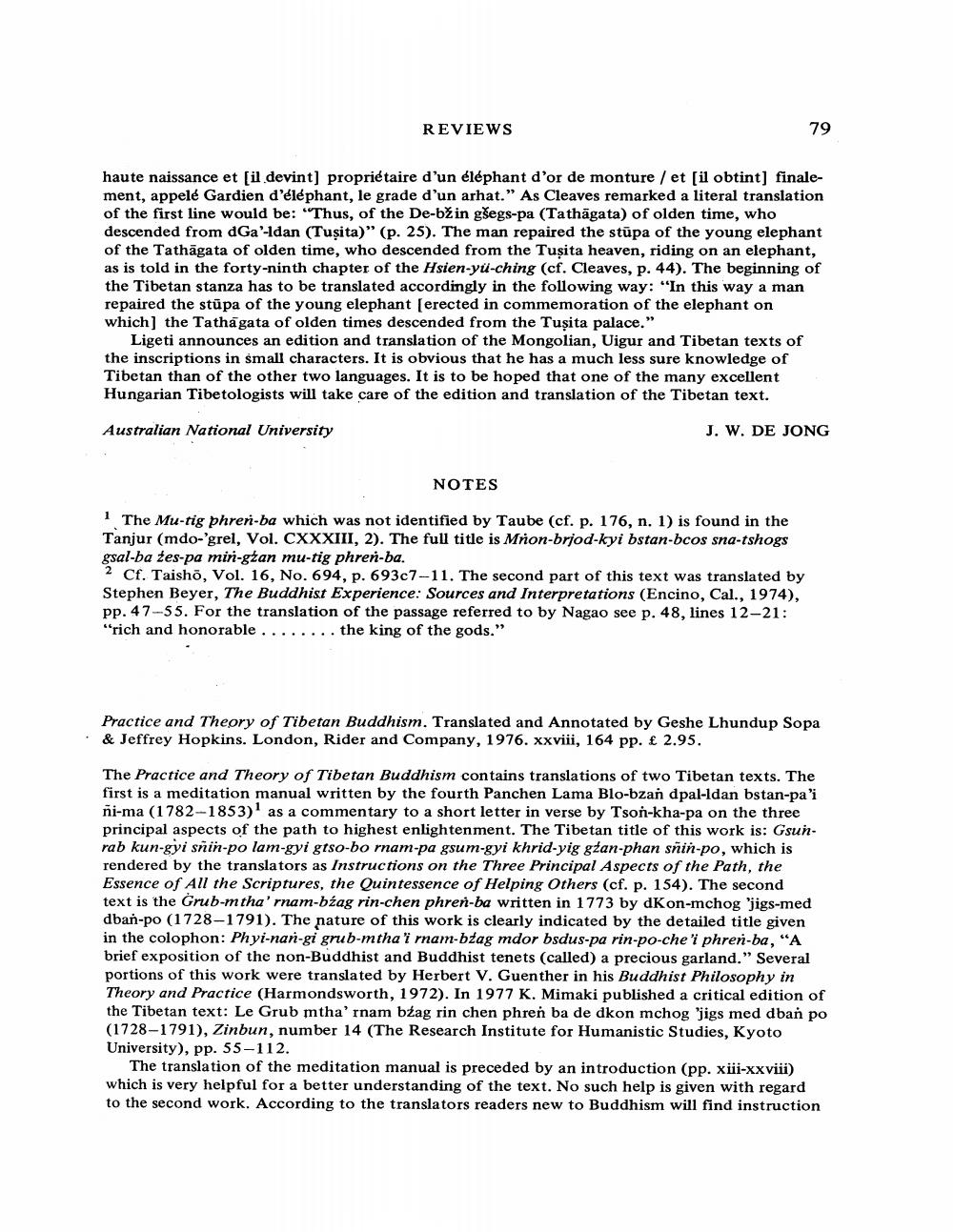Book Title: Book Reviews Author(s): J W De Jong Publisher: J W De Jong View full book textPage 9
________________ REVIEWS 79 haute naissance et fil devint) propriétaire d'un éléphant d'or de monture / et (il obtint] finalement, appelé Gardien d'éléphant, le grade d'un arhat.” As Cleaves remarked a literal translation of the first line would be: "Thus, of the De-bžin gšegs-pa (Tathāgata) of olden time, who descended from Ga'-Idan (Tuşita)" (p. 25). The man repaired the stupa of the young elephant of the Tathāgata of olden time, who descended from the Tușita heaven, riding on an elephant, as is told in the forty-ninth chapter of the Hsien-yu-ching (cf. Cleaves, p. 44). The beginning of the Tibetan stanza has to be translated accordingly in the following way: "In this way a man repaired the stūpa of the young elephant (erected in commemoration of the elephant on which] the Tathagata of olden times descended from the Tuşita palace." Ligeti announces an edition and translation of the Mongolian, Uigur and Tibetan texts of the inscriptions in small characters. It is obvious that he has a much less sure knowledge of Tibetan than of the other two languages. It is to be hoped that one of the many excellent Hungarian Tibetologists will take care of the edition and translation of the Tibetan text. Australian National University J. W. DE JONG NOTES 1 The Mu-tig phren-ba which was not identified by Taube (cf. p. 176, n. 1) is found in the Tanjur (mdo-'grel, Vol. CXXXIII, 2). The full title is Mron-brod-kyi bstan-bcos sna-tshogs gsal-ba tes-pa min-gżan mu-tig phrer-ba. 2 Cf. Taisho, Vol. 16, No. 694, p. 693c7-11. The second part of this text was translated by Stephen Beyer, The Buddhist Experience: Sources and Interpretations (Encino, Cal., 1974), pp. 47-55. For the translation of the passage referred to by Nagao see p. 48, lines 12-21: "rich and honorable ........ the king of the gods." Practice and Theory of Tibetan Buddhism. Translated and Annotated by Geshe Lhundup Sopa & Jeffrey Hopkins. London, Rider and Company, 1976. xxviii, 164 pp. £ 2.95. The Practice and Theory of Tibetan Buddhism contains translations of two Tibetan texts. The first is a meditation manual written by the fourth Panchen Lama Blo-bzan dpal-ldan bstan-pa'i ñi-ma (1782-1853) as a commentary to a short letter in verse by Tson-kha-pa on the three principal aspects of the path to highest enlightenment. The Tibetan title of this work is: Gsun. rab kun-gyi snin-po lam-gyi gtso-bo rnam-pa gsum-gyi khrid-yig głan-phan sñin-po, which is rendered by the translators as Instructions on the Three Principal Aspects of the Path, the Essence of All the Scriptures, the Quintessence of Helping Others (cf. p. 154). The second text is the Grub-mtha'rnam-bżag rin-chen phren-ba written in 1773 by Kon-mchog 'jigs-med dban-po (1728-1791). The nature of this work is clearly indicated by the detailed title given in the colophon: Phyi-nan-gi grub-mtha'i rnam-bżag mdor bsdus-pa rin-po-che' phren-ba, “A brief exposition of the non-Buddhist and Buddhist tenets (called) a precious garland.” Several portions of this work were translated by Herbert V. Guenther in his Buddhist Philosophy in Theory and Practice (Harmondsworth, 1972). In 1977 K. Mimaki published a critical edition of the Tibetan text: Le Grub mtha'rnam błag rin chen phren ba de dkon mchog 'jigs med dbań po (1728-1791), Zinbun, number 14 (The Research Institute for Humanistic Studies, Kyoto University), pp. 55-112. The translation of the meditation manual is preceded by an introduction (pp. xiii-xxviii) which is very helpful for a better understanding of the text. No such help is given with regard to the second work. According to the translators readers new to Buddhism will find instructionPage Navigation
1 ... 7 8 9 10 11 12 13 14 15 16 17 18 19 20 21 22 23 24 25 26 27 28 29 30 31 32 33 34 35 36 37 38
